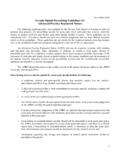Transcription of CDC Guideline for Prescribing Opioids for Chronic Pain ...
1 CDC Guideline for Prescribing Opioids for Chronic Pain United States, 2016. Morphine milligram equivalent (MME) doses for commonly prescribed Opioids opioid Conversion Factor Codeine Fentanyl transdermal (in mcg/hr). Hydrocodone 1. Hydromorphone 4. 1 20 mg/day 4. 21 40 mg/day 8. 41 60 mg/day 10. 61 80 mg/day 12. Morphine 1. Oxycodone Oxymorphone 3. Tapentadol Clinicians should use caution when Prescribing Opioids at any dosage, should carefully reassess evidence of individual benefits and risks when increasing dosage to 50 morphine milligram equivalents (MME)/day, and should avoid increasing dosage to 90 MME/day or carefully justify a decision to titrate dosage to 90 MME/day Source: Adapted from Von Korff M, Saunders K, Ray GT, et al. Clin J Pain 2008;24:521 7 and Washington State Interagency Guideline on Prescribing Opioids for Pain ( ).
2 *Multiply the dose for each opioid by the conversion factor to determine the dose in MMEs. For example, tablets containing hydrocodone 5 mg and acetaminophen 300 mg taken four times a day would contain a total of 20 mg of hydrocodone daily, equivalent to 20 MME daily; extended-release tablets containing oxycodone 10mg and taken twice a day would contain a total of 20mg of oxycodone daily, equivalent to 30 MME daily. The following cautions should be noted: 1) All doses are in mg/day except for fentanyl, which is mcg/hr. 2) Equianalgesic dose conversions are only estimates and cannot account for individual variability in genetics and pharmacokinetics. 3) Do not use the calculated dose in MMEs to determine the doses to use when converting opioid to another; when converting Opioids the new opioid is typically dosed at substantially lower than the calculated MME dose to avoid accidental overdose due to incomplete cross-tolerance and individual variability in opioid pharmacokinetics.
3 4) Use particular caution with methadone dose conversions because the conversion factor increases at higher doses. 5) Use particular caution with fentanyl since it is dosed in mcg/hr instead of mg/day, and its absorption is affected by heat and other factors.. Tapentadol is a mu receptor agonist and norepinephrine reuptake inhibitor. MMEs are based on degree of mu-receptor agonist activity, but it is unknown if this drug is associated with overdose in the same dose-dependent manner as observed with medications that are solely mu receptor agonists.


